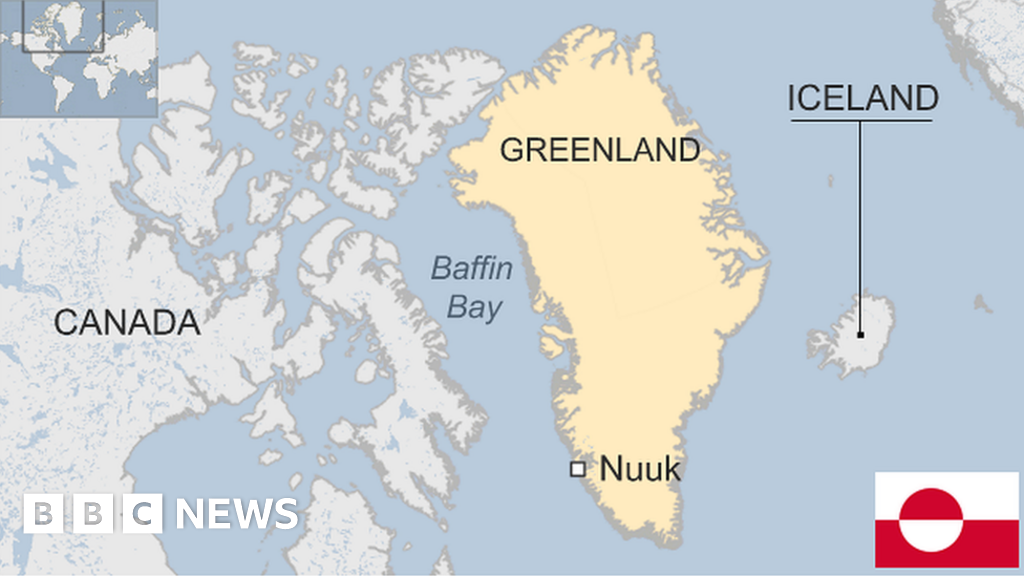Greenland is the world’s largest island and an autonomous Danish dependent territory with self-government and its own parliament.
Though a part of the continent of North America, Greenland has been politically and culturally associated with Europe – in particular the two colonial powers, Norway and Denmark – since the 9th Century.
Denmark contributes two-thirds of Greenland’s budget revenue, the rest coming mainly from fishing. Potential oil, gas and rare earth mineral reserves have attracted prospecting firms.
Greenland enjoys perpetual daylight for two months each year. Over 80% of the island is covered by a permanent ice cap 4km thick in places. Global warming is causing this to melt but has also increased access to Greenland’s mineral resources.
The US has long seen Greenland as strategically important and established a radar base at Thule at the start of the Cold War.
GREENLAND: FACTS
- Capital: Nuuk
- Area: 2,166,086 sq km
- Population: 56,000
- Languages: Greenlandic, also Danish and English
- Life expectancy: 71 years (men) 76 years (women)
Image source, Getty Images
LEADERS
Head of State: King Frederik X of Denmark
Prime Minister of Greenland: Mute Bourup Egede
Image source, Getty Images
Mr Egede took over in April 2021 after his left-wing Inuit Ataqatigiit party won parliamentary elections on a platform of halting a rare metals mining project on environmental grounds.
Disagreement over the project led to the collapse of the previous government earlier in the year, paving the way for snap elections.
Broadcasting in Greenlandic and Danish is the main source of news and entertainment.
There are no daily newspapers. The major titles – a weekly and a bi-weekly – publish in Greenlandic and Danish.
TIMELINE
Image source, Getty Images
Some key dates in Greenland’s history:
982 – Greenland discovered by the Norwegian, Erik the Red, who calls his discovery “Greenland” to make it more attractive. In 986 he returns with settlers.
14th-15th Centuries – Norse settlements disappear, perhaps at the onset of the Little Ice Age as temperatures fall significantly.
1721 – An expedition led by Danish-Norwegian missionary Hans Egede sees new Danish colonisation. A new settlement is established near present-day capital, Nuuk.
1940 – Denmark is occupied by Germany during World War Two.
1941-1945 – United States occupies Greenland to defend it against a possible invasion by Germany.
1950 – Denmark agrees to allow the US to regain the use of Thule Air Base which is greatly expanded between 1951 and 1953 as part of a Nato Cold War defence strategy.
1953 – Greenland becomes an integral part of the Kingdom of Denmark.
1979 – Greenland attains home rule following a referendum.
1985 – Greenland leaves the European Economic Community (EEC) over disagreement with EEC commercial fishing regulations and an EEC ban on seal skin products.
1999 – Danish High Court rules that Inuit were illegally exiled from their land in northern Greenland in 1953 to expand US airbase at Thule but denies them right of return.
2008 – Greenlanders vote in referendum for more autonomy, greater control over energy resources and granting Kalaallisut or Western Greenlandic status of official language in place of Danish.
2010 – Greenland’s ice sheet is shrinking faster and making a bigger contribution to rising sea levels, a study in the journal Science confirms.
2013 – Greenland ends the territory’s 25-year ban on the mining of radioactive materials such as uranium, leading to a boom in mineral resource exports.
2021 – Greenland bans all new oil and gas exploration in its territory. Government officials say the environmental “price of oil extraction is too high”.
Rain falls on the summit of Greenland’s ice cap for the first time in recorded history, which scientists attribute to climate change
Image source, Getty Images

